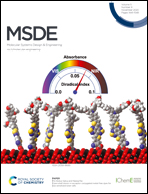Multiscale molecular modelling for the design of nanostructured polymer systems: industrial applications
Abstract
One of the major goals of computational materials science is the rapid and accurate prediction of properties of new materials. In order to design new materials and compositions for specific, high-performance applications, it is essential to rely on predictive tools for the estimation of the desired properties before material preparation, characterization and processing. In the future, new materials and systems will be characterized by progressively higher degrees of complexity, due to the strong relationship between nanotechnology, biotechnology, computer science and cognitive disciplines. However, computer power and simulation algorithms are also quickly evolving, opening new avenues for novel material and system design based on virtual (aka in silico) experiments. Notwithstanding the great advances achieved in the simulation of structural, thermal, mechanical and transport properties of materials at the macroscopic level, the accurate property prediction for complex nanostructured materials remains a critical issue in the material design strategy. This hurdle arises from the strong dependence of the material properties on the underlying nanostructure. Atomistic simulations based on molecular dynamics or Monte Carlo methods allow such structure–property relationships to be derived already for systems of noticeable size and time scales; yet, the study of highly complex systems (e.g., polymer nanocomposites and self-assembled nanomaterials) is still out of current reach at such a fine level of detail. Indeed, the fast advancement of high-performance computing has already expanded these time/scale windows, and the upcoming advent of hexascale and/or quantum-based computers will indeed further contribute to this expansion; yet, the investigation of many critical phenomena will remain inaccessible to atomistic-based simulations. To circumvent this limitation, multiscale simulation techniques have been developed to create a seamless bridge across different time/scale domains (from electronic to continuum methods), thereby providing reliable predictive tools to design engineers. Accordingly, in this review work we present a selection of case studies based on our own experience in multiscale molecular modeling of nanostructured, complex systems of industrial interest. The main goal of this objective is to show how multiscale in silico experiments in molecular systems design and engineering is at the same time theoretically sound and mature enough for its full exploitation.



 Please wait while we load your content...
Please wait while we load your content...